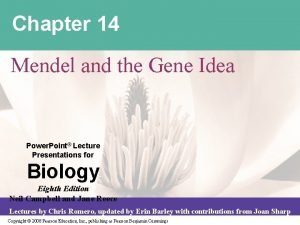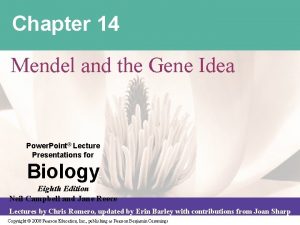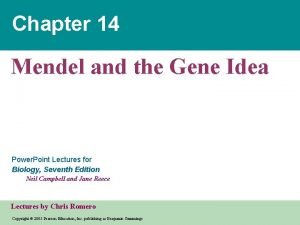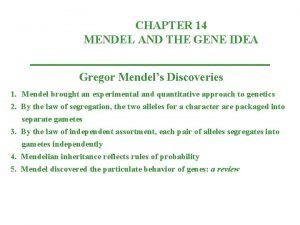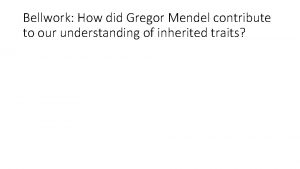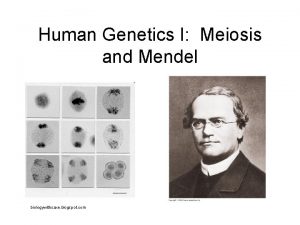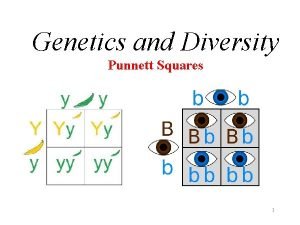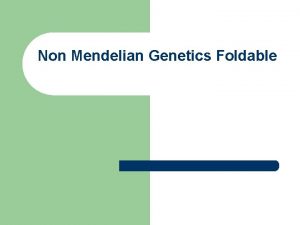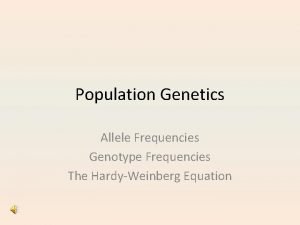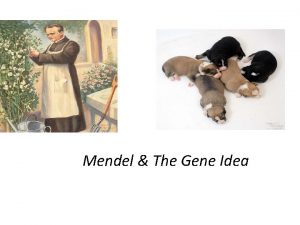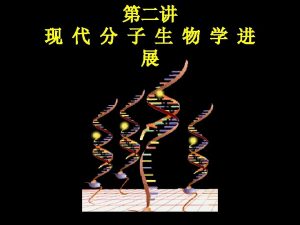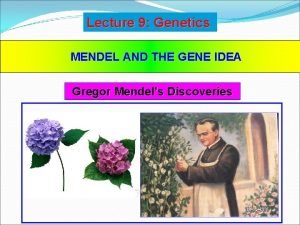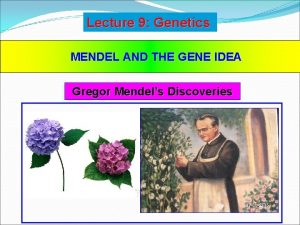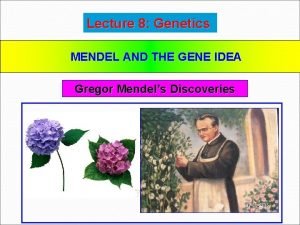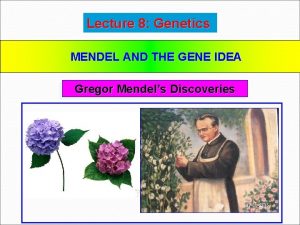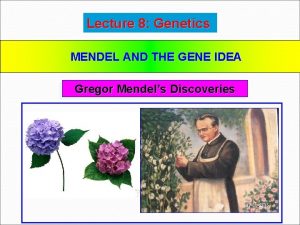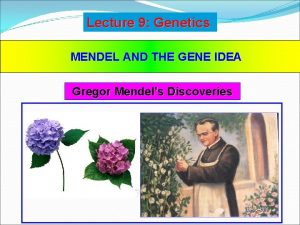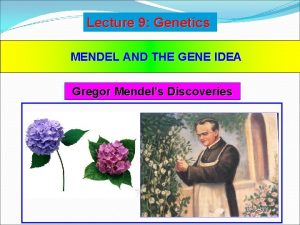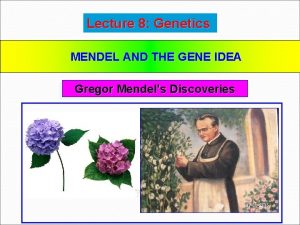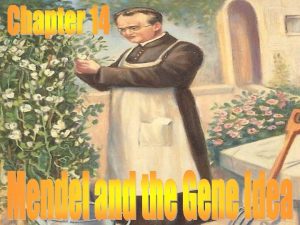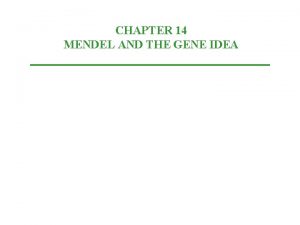Lecture 8 Genetics MENDEL AND THE GENE IDEA
















- Slides: 16

Lecture 8: Genetics MENDEL AND THE GENE IDEA Gregor Mendel’s Discoveries

Objectives Distinguish between dominant and recessive traits. State two laws of heredity that were developed from Mendel’s work. Describe how Mendel’s results can be explained by scientific knowledge of genes and chromosomes. Differentiate between the genotype and the phenotype of an organism. Explain how probability is used to predict the results of genetic crosses.

Mendel brought an experimental and quantitative approach to genetics Around 1857, Mendel began breeding garden peas to study inheritance ﻭﺭﺍﺛﺔ. Because they are available in many varieties with distinct heritable ﺗﻮﺍﺭﺙ characters ﺻﻔﺎﺕ with different traits (genes). • Each pea plant has male (stamens) and female (carpel) sexual organs. • In nature, pea plants typically self-fertilize ﺗﻠﻘﻴﺢ ﺫﺍﺗﻲ , fertilizing ova with their own pollens. • However, Mendel could also move pollens ﺣﺒﻮﺏ ﺍﻟﻠﻘﺎﺡ from one plant to another to cross-pollinate ـﻠﻘﺢ plants.

Three Steps of Mendel’s Experiments

Mendel’s Results and Conclusions Recessive and Dominant Traits Ø Mendel concluded that inherited characteristics are controlled by factors that occur in pairs. Ø In his experiments on pea plants, one factor in a pair masked the other. The trait that masked the other was called the dominant trait. The trait that was masked was called the recessive trait.

In a breeding experiment, Mendel would cross-pollinate ( ﺗﻠﻘﻴﺢ ﺧﻠﻄﻲ hybridize )ﺟﻦ two contrasting ﻣﺘﺒﺎﻳﻨﻴﻦ , true-breeding pea varieties ﺃﻨﻮﺍﻉ. The true-breeding parents are the P (Parental generation) and their hybrid offspring ﺍﻟﻨﺴﻞ ﺍﻟﻫﺠﻦ are the F 1 (1 st Filial generation). Mendel would then allow the F 1 (1 st Filial generation) hybrids to self-pollinate to produce an F 2 generation. It was mainly Mendel’s quantitative analysis ﺗﺤﻠﻴﻞ ﻛﻤﻲ of F 2 plants that revealed the two fundamental lows of heredity: A)- The law of segregation. B)- The law of independent assortment.

A)- Law of segregation: ( )ﻗﺎﻧﻮﻥ ﺍﻹﻧﻌﺰﺍﻝ the two alleles ﭽـﻴﻨﺎﺕ for a character are isolated into separate gametes Mendel expected that the F 1 hybrids from a cross ﺗﻠﻘﻴﺢ between purpleflowered and white-flowered pea plants would have pale purple flowers ﺑﻨﻔﺴﺠﻲ ﺑﺎﻫﺖ. Instead, ﻭﻟﻜﻦ the F 1 hybrids all have purple flowers, just a purple like their parents. • This cross produced a 3 purple to 1 white ratio of traits in the F 2 offspring, • Mendel reasoned that the heritable factor for white flowers was present in the F 1 plants, but it did not affect flower color. • Thus, purple flower is a dominant color ( )ﺻﻔﺔ ﺳﺎﺋﺪﺓ and white flower is a recessive color ( )ﺻﻔﺔ ﺗﻨﺤﻴﺔ. 7

Mendel found similar 3 : 1 ratios of two traits among F 2 offspring when he conducted crosses for six other characters, each represented by two different varieties ﺻﻔﺘﻴﻦ ﻣﺨﺘﻠﻔﺘﻴﻦ. For example, when Mendel crossed two true-breeding varieties, one of which produced round seeds ﺑﺬﻭﺭ ﺳﺘﺪﻳﺮﺓ , the other of which produced wrinkled seeds ﺑﺬﻭﺭ ﻋﺪﺓ , all the F 1 offspring had round seeds, but among the F 2 plants, 75% of the seeds were round and 25% were wrinkled (see second low in the next lecture).


Mendel developed a hypothesis ﺍﻓﺘﺮﺍﺽ to explain these results that consisted of four related ideas. 1 - Alternative version of genes (different alleles )ﺍﻟـﭽﻴﻨﻴﻦ ﺍﻟﻤﺘﻘﺎﺑﻠﻴﻦ account for variations in inherited characters. 2 - Different alleles vary somewhat in the sequence of nucleotides at the specific locus ﻣﻮﺿﻊ of a gene. 3 - For each character, an organism inherits ﻳﺮﺙ two alleles, one from each parent. 4 - These homologous loci ﻭﻩ ﻋﻠﻰ ﺍﻟﻜﺮﻭﻣﻮﺳﻮﻡ may be differ – In the flower-color example, the F 1 plants inherited a purple-flower allele from one parent and a white-flower allele from the other.

Mendelian inheritance reflects rules of probability for the behaviour of genes (alleles). Alleles segregate ﺗﻨﻔﺼﻞ because of the distribution of homologous chromosomes to different gametes in meiosis. For each character, an organism inherit two alleles (one from each parent). Homologous chromosomes Red colour gene (allele) White colour gene (allele) If the two alleles differ, one of them will be Dominant, and the other is Recessive. The two alleles (genes) for a character are separated (segregated) into separate gametes (summarized as Mendel’s law of segregation) and aggregated again by fertilization.

• Mendel’s law of segregation accounts for the 3: 1 ratio in the F 2 generation. • The F 1 hybrids will produce two classes of gametes, half with the purple-flower allele and half with the white-flower allele. • During self-pollination, the gametes of these two classes unite randomly. This can produce four equally likely combinations of sperm and ovum. • A Punnett square predicts the results of a genetic cross between individuals of known genotype ﺍﻟﻄﺮﺯ ﺍﻟـﭽﻴﻨﻲ. • • A Punnett square analysis of the flower-color example demonstrates Mendel’s model accounts for the 3: 1 ratio in the F 2 generation

Pea plant PP X pp Pp X Heterozygous Pp Homozygous P Dominant allele P p PP Pp P p p Pp Recessive allele 100% Purple F 1 generation 3 Purple Pp : pp 1 White F 2 generation 13

Phenotype (Colour) Phenotype: Is the organism’s appearance ﺍﻟﻄﺮﺯ ﺍﻟﻤﻈﻬﺮﻱ. Genotype: Is the organism’s genetic makeup ﺍﻟﻄﺮﺯ ﺍﻟـﭽﻴﻨﻲ. PP ﻣﺘﻤﺎﺛﻞ ﺍﻟﺠﻴﻨﺎﺕ PP Homozygous pp An organism having a pair of identical alleles Genotype (Genetic makeup) Pp ﻣﺘﺒﺎﻳﻦ ﺍﻟﺠﻴﻨﺎﺕ Heterozygous An organism having a pair of two different alleles 14

For flower color in peas, both PP and Pp plants have the same phenotype (purple) but different genotypes (homozygous and heterozygous). The only way to produce a white phenotype is to be homozygous recessive (pp) for the flowercolor gene.

It is not possible to predict the genotype of an organism with a dominant phenotype. The organism must have one dominant allele, but it could be homozygous dominant or heterozygous. Test cross, is breeding a homozygous recessive with dominant phenotype, but unknown genotype, can determine the identity ﺗﻄﺎﺑﻖ ﺃﻮ ﺗﺸﺎﺑﻪ of the unknown allele. Q: What is the result of Cross hybridization of purple X white colored flowers ? 16
 Mendel and the gene idea chapter 14
Mendel and the gene idea chapter 14 Chapter 14 mendel and the gene idea
Chapter 14 mendel and the gene idea Chapter 14 mendel and the gene idea
Chapter 14 mendel and the gene idea Chapter 14 mendel and the gene idea
Chapter 14 mendel and the gene idea Chapter 14 mendel and the gene idea
Chapter 14 mendel and the gene idea Chapter 14 mendel and the gene idea
Chapter 14 mendel and the gene idea Altura de andrew garfield
Altura de andrew garfield Gregor mendel a monk
Gregor mendel a monk Gregor mendel
Gregor mendel Chapter 11 biology test
Chapter 11 biology test How did gregor mendel contribute to genetics
How did gregor mendel contribute to genetics Meiosis
Meiosis Cross two heterozygous tall stem height
Cross two heterozygous tall stem height Mendel's genetics foldable
Mendel's genetics foldable Genetics since mendel
Genetics since mendel Gene frequency
Gene frequency Gene by gene test results
Gene by gene test results
